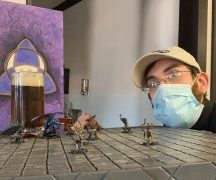The Ohio Department of Health released a study Thursday of July data showing — at that time, at least — its count of COVID-19 infections was thousands short, as evidenced by antibody and diagnostic testing.
Between July 9 and July 28, ODH surveyed 727 randomly selected people from around Ohio to take different viral tests for the new coronavirus, which causes COVID-19, to detect prior or current infections.
About 23,000 Ohioans were diagnosed with COVID-19 during the study’s data collection period. The data released Thursday would suggest the true infection count would have been closer to 80,000, “suggesting that total cases in the state were approximately 3.5 times as high as diagnosed cases.”
On July 28, ODH reported about 86,000 known infections, cumulatively. Analysis of antibody testing data released Thursday estimates about 133,000 Ohioans would show evidence of prior infection, at the time.
The undiagnosed cases may have been mild and without serious complications, but they show how stealthily the virus can spread, likely finding hosts more susceptible to complications along the way.
Despite the underestimation of total infections, the data indicates the overwhelming majority of Ohioans have not yet been infected. Community spread is ongoing and most of the 11.7 million state residents remain susceptible.
“The goal is to get to herd immunity, and we’re going to need a vaccine to do that,” said Lt. Gov. Jon Husted at a press conference.
The term ‘herd immunity’ refers to a point in which enough people are immune to a disease — likely due to prior exposure or vaccination — that a pathogen dies out when it can’t find any hosts to infect and pass it along.
“We’re not gonna get that without the vaccine,” Gov. Mike DeWine said Thursday. “We’re not going to work our way into this for years. So what we have to do is hang in there, keep this virus low, we’ve got to keep our foot on its neck, and wait.”
Dr. William Miller, an infectious disease expert at Ohio State University who helped design the study, said it shows two key trends. For one, the reported cases are only a fraction of the true case count; and for two, most Ohioans have no immunity to the new coronavirus and must remain vigilant against it.
“It just means that we’re clearly in this for kind of a long haul,” he said. “We have to recognize that and manage our expectations of thinking things are going to go back to normal next week.”
The data has limitations. It was collected amid a statewide and national case surge and is now more than two months old. It’s also a limited sample size.
An ODH Spokeswoman, asked to explain the two-month delay between the end of data collection and its eventual release, said it “took time to collect all the data and analyze it and make the final report.”
Current data released Thursday depicts a virus increasingly digging into Ohio communities.https://platform.twitter.com/embed/index.html?creatorScreenName=https%3A%2F%2Ftwitter.com%2Fjake_zuckerman&dnt=true&embedId=twitter-widget-1&frame=false&hideCard=false&hideThread=false&id=1311729859501207555&lang=en&origin=https%3A%2F%2Fohiocapitaljournal.com%2F2020%2F10%2F02%2Fstudy-ohios-covid-19-data-might-be-a-threefold-underestimation%2F&siteScreenName=OhioCapJournal&theme=light&widgetsVersion=ed20a2b%3A1601588405575&width=550px
On the latest Ohio Public Health Advisory System map — a reflection of seven different indicators like infection rates and doctor visits — 11 counties are red (“very high exposure and spread”) and a supermajority of Ohio counties are orange (“increased exposure and spread”).
More than 155,000 Ohioans have been infected, and the seven-day moving average has risen seven days in a row. More than 15,000 have been hospitalized from the disease, and 4,817 have died.
***
Also from Ohio Capital Journal:
Small COVID-19 numbers reported in schools, with some spikes
Schools across the state have largely seen single-digit amounts of COVID-19 cases, but the state has not been without its spikes.
In the most recent numbers, released Thursday by the state, cases came from preschools to high schools, private schools and public schools.
Children aged 0-19 represent the fifth highest age group in terms of COVID-19 cases, according to current state overall data on the pandemic.
The state has reported 10,133 total cases for children below age 18, with 242 hospitalizations and 1 death. The case number represents 7% of the total cases, according to the Ohio Department of Health. READ MORE
DeWine’s tough spot shows in Thursday presser
Ohio Gov. Mike DeWine on Thursday provided a glimpse of how difficult it is to be a traditional Republican officeholder in the era of Trump.
The governor has been holding regular press briefings since the spring, when the coronavirus began tightening its deadly grip around the Buckeye State. But on Thursday, he started off by deploring Tuesday’s presidential debate between Donald Trump and Joe Biden, which has been almost universallypanned as an uncivil shout fest.
According to one count, the interruptions came at the rate of one a minute, and Trump was the interrupter 75% of the time. Trump also stirred controversy by refusing to condemn a right-wing hate group, unleashed a torrent of false claimsabout the integrity of the vote, and again refused to say that he would accept the independently certified results of an election that polls say he is currently losing.
On Thursday, DeWine reiterated his support for Trump while criticizing the debate generically. READ MORE





